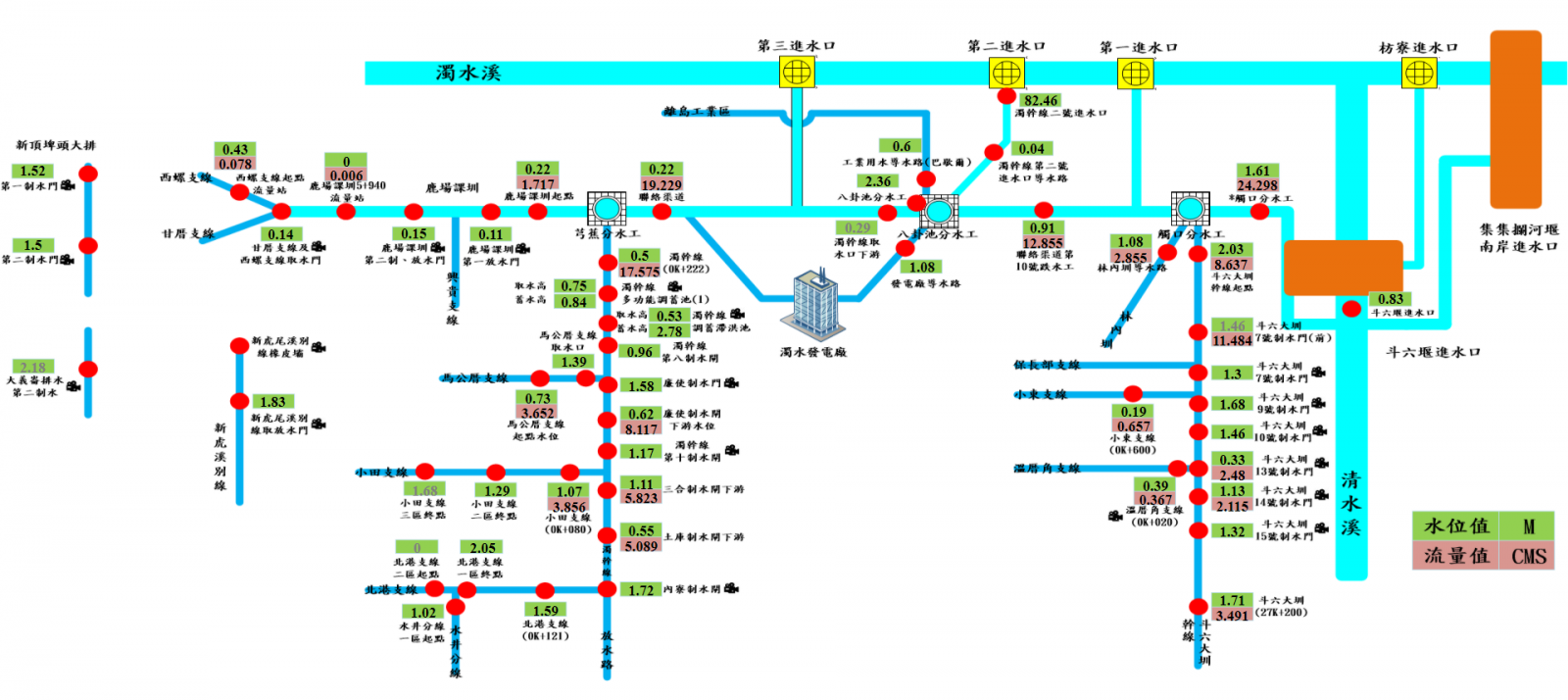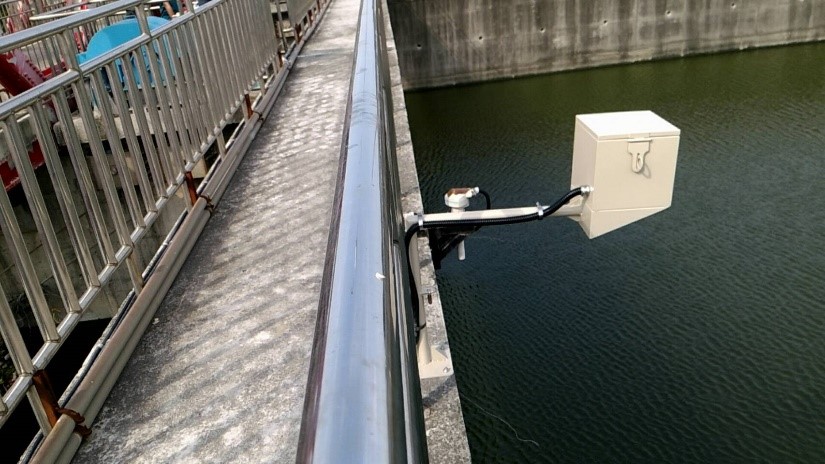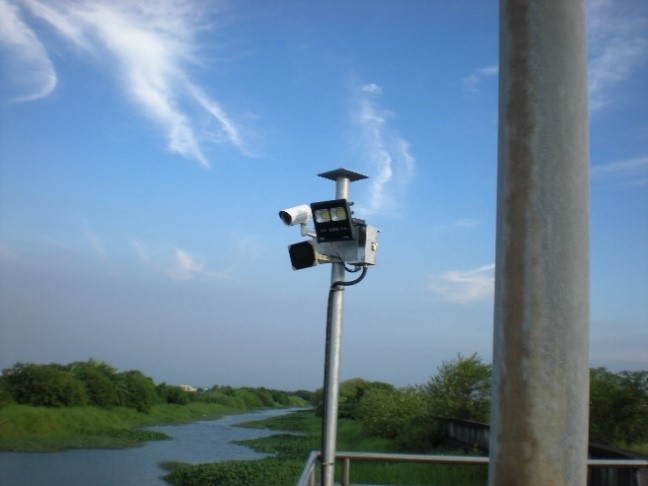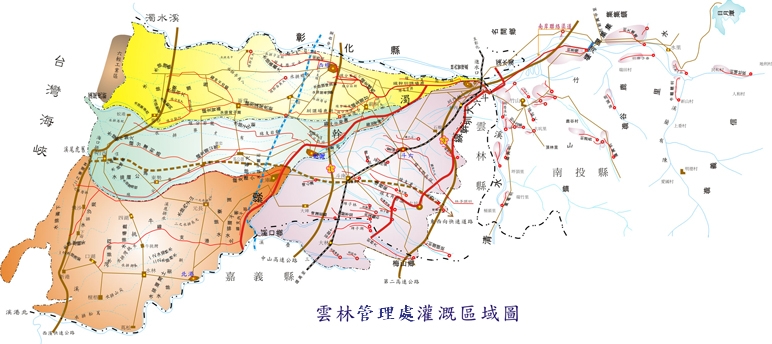
The area controlled by the office was located in southwest Taiwan, stretching from Chenyoulan River in Nantou County west along the western foothills of the Central Mountains range, to the Taiwan Strait, from Zhuoshui River in the north to Sandie River in Chiayi County in the south, approximately 40km from north to south and 80km from east to west. The administrative area encompasses 30 townships and cities in Nantou, Yunlin, and Chiayi counties, and has an current irrigated land area of about 63,510 hectares.
The average annual rainfall in the irrigation area is about 1,500mm and although abundant it is also unevenly distributed across the four seasons. The rainy season, from May to October, accounts for about 80% of the annual rainfall. The dry season from November to April accounts for about 20% of annual rainfall.
The main water sources are Zhuoshui River, Qingshui River, Beigang River and Xinhuwei River, and stream-type irrigation is employed. Irrigation systems are mostly operated on a rotational basis.
The office’s main irrigation water sources are Zhuoshui River, Qingshui River and Beigang River, with 459 groundwater wells and 56 subsidized water sources having been dug. Average annual water consumption is about 1.43 billion m3, of which about 1.29 billion m3 is taken from surface water, with diverted return water and groundwater accounting for approximately 140 million m3. In order to stabilize these water sources, the Jiji joint water diversion plan was developed, with a permanent barrage weir project to be constructed.
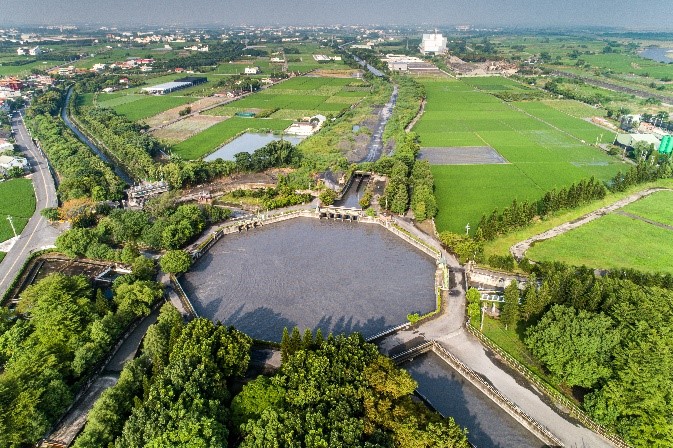
Water is an important natural resource for any country, necessary for national life, and the driving force in the development of agriculture and industry. Especially in recent years, sudden economic changes at home and abroad have made the demand for water resources all the more urgent. Water should be cherished and effectively utilized. Facing limited water resources, the office has strengthened irrigation water management policies and adopted the following water saving methods
- Manages the comprehensive regulation and utilization of the Zhuoshui River and Qingshui River water systems to improve the water provision and land.
- Makes advance arrangements to respond to water shortages and develop drought relief measures to improve the office’s ability to respond to changes.
- Regulates irrigation water distribution to spread out peak water use, during water shortage seasons.
- Reuses agricultural return water and residual water to irrigate areas with insufficient ground water.
- Set up irrigation regulating storage pool to retain irrigation water so it can be effectively used during water shortages or dry periods.
- Implements rotational irrigation measures to enhance irrigation efficiency and reduce water transmission losses in the main, lateral and branch canals.
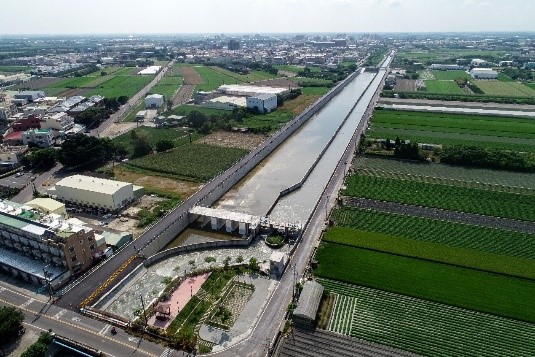
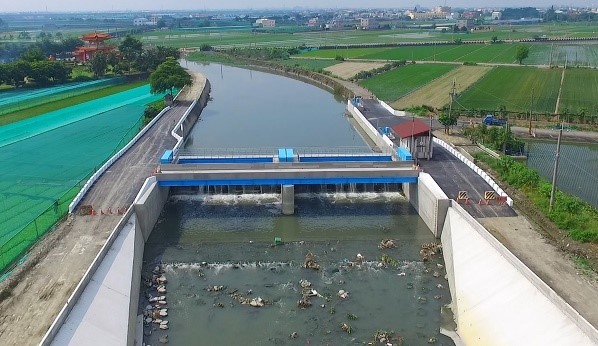
- The office handles farmland drainage maintenance and management in accordance with operational plans to maintain the functions of drainage channels at all levels within its jurisdiction, ensuring smooth drainage, and preventing disasters caused by the flooding of farmland and seawater intrusion in coastal areas. Inspections and maintenance management are strengthened on a daily basis.
- In order to maintain smooth drainage channels, pipe irrigation and drainage gates at all levels are operated in accordance with regulations before typhoons and flood seasons, and safety inspections are completed to ensure normal functioning.
- After the flood season, regular safety inspections of "waterproof and drainage irrigation structures" should be conducted from November to February to reduce or avoid the occurrence of disasters. Irregular safety inspections of "waterproofing, drainage irrigation structures" should be carried out immediately after earthquakes, floods, heavy rainfall or other incidents above certain thresholds.
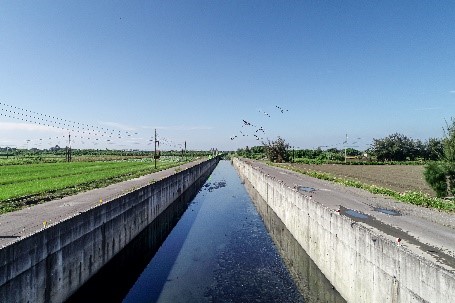
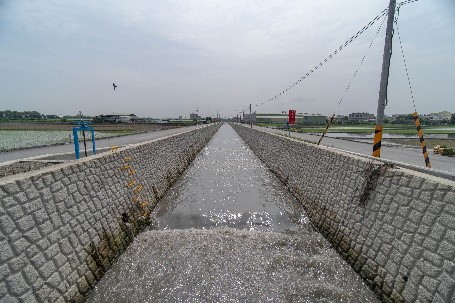
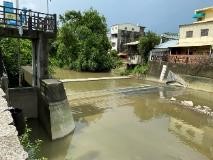
In order to prevent the pollution of irrigation water, this office established 1,266 livestock farming waterway arrangement households and 215 monitoring points, and has included monitoring data in computer files thereby facilitating tracking and processing at any time. Monitoring stations have been set up at each workstation, equipped with testing instruments, and samples are taken to test water temperature, pH and conductivity every two months. Unscheduled spot inspections of polluted water sources have been stepped up. If it is found that any water source is inconsistent with required irrigation water quality standards, it is reported to the competent authorities with penalties levied in accordance with law and orders issued for improvements to be made within a set period of time. The results have been remarkable.
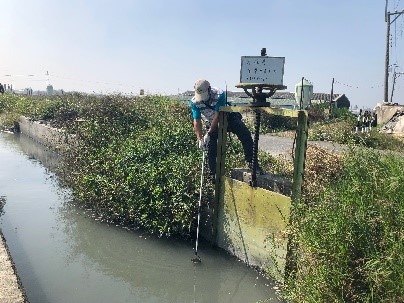
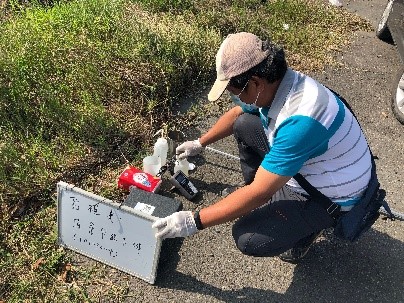
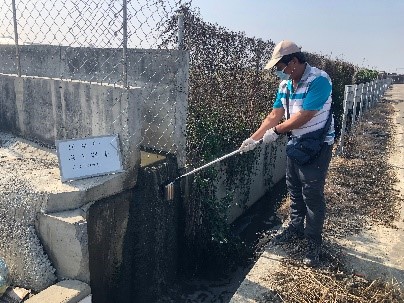
Although the office’s irrigation system mainly irrigates rice paddies, dry farming irrigation is still implemented every year out of consideration for the abundance and dryness of water sources. Traditional dry farming irrigation is mostly flood irrigation, which is uneven and wastes water resources. The government is currently subsidizing relevant funds to develop pipeline irrigation facility management. The office actively cooperates with the operation and helps farmers submit applications, surveys and accepts the facilities. The application area reaches more than 300 hectares ever year, which saves water and manpower needed for farmland management, and promotes the technological development of precision agriculture and smart irrigation. This approach made a major contribution and is a great blessing to farmers.
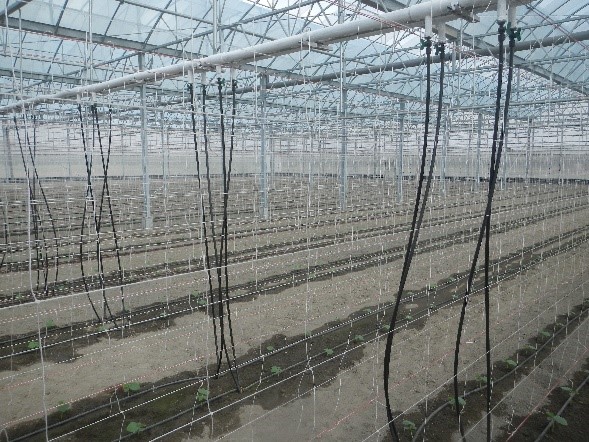
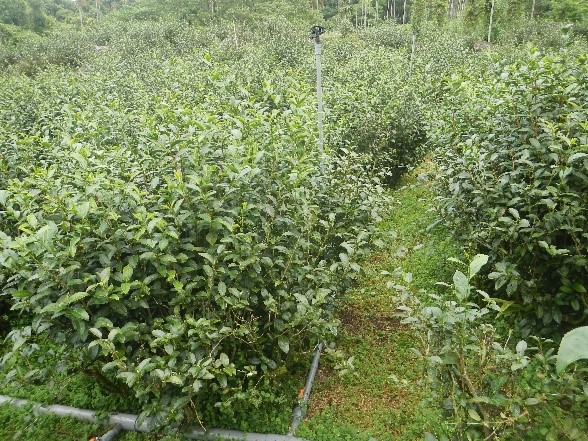
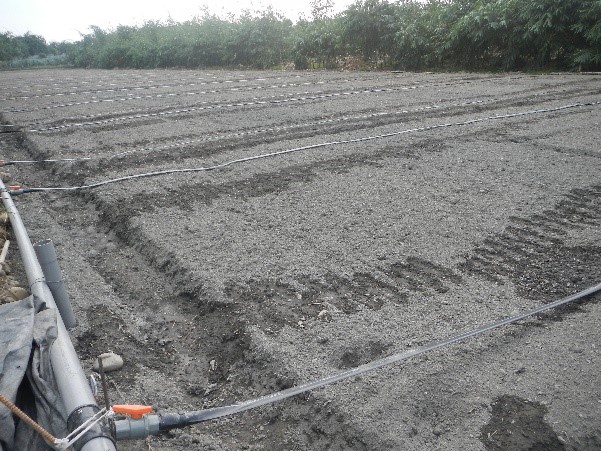
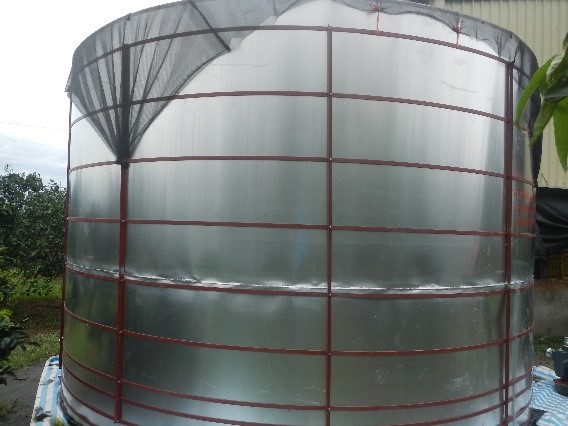
The office has established a total of 506 working groups and 1,585 classes, across 42 irrigation work stations. According to the "Establishment and Management Regulations for Irrigation Working Groups," group leaders are selected by the management office and submitted to the Irrigation Agency for approval. Class leaders are appointed by the group leader and submit reports to the Irrigation Agency for future reference.
The office uses the workstations to implement fundamental training and promote government laws and policies when holding group leader discussion meetings or basic level social gatherings to celebrate the Irrigation Festival; It also confirms the needs of workstation co-workers through irrigation working group leader meetings, and the workstation then recruits appropriate candidates to serve the area and assist with water use order management and channel maintenance; a joint meeting of group leaders and class leaders is held every year, where the director leads the relevant supervisors in holding face-to-face discussions with basic level groups to reduce the distance between them. When faced with the group leader's suggestions, the director or supervisor personally explains and replies, immediately instructing the organizing unit to deal with issues in a way that facilitates the quickly and effective resolution of basic level problems.
In order to create healthy competition among groups and thereby improve their functionality, group operation evaluations are conducted annually, with outstanding irrigation groups and individuals receiving awards at the Irrigation Festival celebration to encourage basic level personnel to embrace the spirit of service.
In accordance with the provisions of "Paragraph 1, Article 12 of the Irrigation Act: applicants may apply to the Competent Authority for authorization to concurrently use such facilities for other purposes" while "Article 9 of the Irrigation and Drainage Management Regulations" promulgated by the Irrigation Agency, deals with applications to build bridges and culverts, building access crossings, and installing underground facilities, pipelines or cables etc. The applicant fills out the application form, prepares the attachments and submits it to the corresponding workstation for review. After paying a building usage fee the office issues a construction permit and on completion a usage consent letter. In addition, as a benefit to farmers, any application to build bridges and culverts for agricultural facilities (engaged in direct production or farmhouses), when the length of each piece of land is less than 6 meters, is exempt from usage fees.
The main irrigation water source under the office jurisdiction is Zhuoshui River. However, because the water source contains high sand content, irrigation and drainage channels at all levels often accumulate a large amount of mud and sand after water starts to flow, resulting in the rapid spread of weeds and seriously affecting irrigation and drainage. In order to maintain the operation of drainage channels, each office branch is equipped with 2 excavators to assist in daily channel maintenance, disaster prevention and emergency dredging.

Proper control of the opening and closing of groundwater wells. When water is needed for supplementary irrigation, the workstation will provides irrigation water on receiving a request by phone. The priority of irrigation water provision is clearly defined, and priority given to supplementing water sources or those with small water output losses. This not only saves on electricity costs but also greatly improves the efficiency of supply and irrigation.
Installing a time controller with a 24 hours day cycle. Setting water pumping to stop at low peak hours at night and automatically turning the water pump on and off can save about 25% of the annual electricity bill.
When rainfall reaches the established effective rainfall level, the water pump is automatically turned off to avoid water resources waste.
Supplementary water sources and groundwater wells are an important irrigation water source used by the office. However, due to long-term use, the water permeability of groundwater wells has deteriorated, and water output cannot sustain pumping efficiency. Alternatively, well pipes break and sand is produced. As such, after a well is cleaned and water provision expanded, if the expected results cannot be achieved, the office immediately replaces old groundwater wells with new ones. Unfortunately, when wells are drilled, errors can occur when drillers take sand samples, which affects the determination of the location and thickness of water bearing formations.
Therefore, the office implements electric well logging, which can compare sand samples to correct sampling errors and obtain the correct location, thickness and water permeability of water bearing formations. After the well is drilled and water tested, the results can be compared with the results of the pumping test. Such comparisons help to improve the quality of the well drilling.
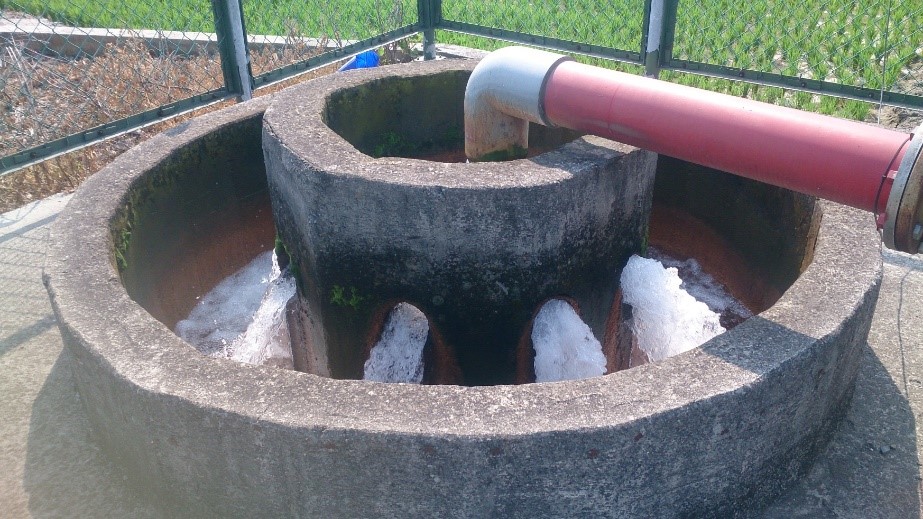
In recent years, due to the impact of abnormal global climate changes, Taiwan has experienced heavy rainfall during its annual flood season, with sudden rainfall and rainfall duration also highly concentrated, often causing disastrous floods or landslides, resulting in huge losses in agricultural production in disaster-stricken areas.
Since 2011, the office has successively built automatic hydrological reporting systems for important sluice gate structures in canals at all levels, including automatic detection of water level and flow and remote gate monitoring. Constructing automatic hydrological reporting systems has strengthened agricultural water use. Effective control and dispatching can improve the efficiency of farmland irrigation, increase disaster early warning time, and improve the efficiency of emergency responses, as well as avoid disasters caused by failure to respond, thereby ensuring people and their property remain safe.
